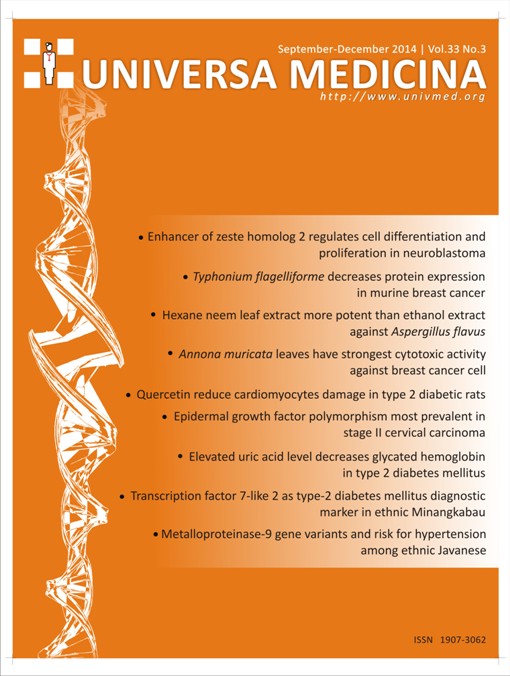Typhonium flagelliforme decreases protein expression in murine breast cancer
Main Article Content
Abstract
Article Details
Issue
Section
The journal allows the authors to hold the copyright without restrictions and allow the authors to retain publishing rights without restrictions.
How to Cite
References
Kimman M, Norman R, Jan S, Kingston D, Woodward M. The burden of cancer in member countries of the Association of Southeast Asian Nations (ASEAN). Asian Pac J Cancer Prev 2012;13:411- 20.
Ferlay J, Shin HR, Bray F, Forman D, Mather C, Parkin DM. Estimates of world wide burden of cancer in 2008: GLOBOGAN 2008. Int J Cancer 2010;127:2893- 917.
Rakha E, Filho JS, Baechner F, Dabbs D, Decker T, Eusebi V, et al. Breast cancer prognostic classification in the molecular era: the role of histological grade. Breast Cancer Res 2010;12:
doi:10.1186/bcr2607.
Parkin DM, Bray F, Ferlay J, Pisani P. Global cancer statistics, 2002. CA Cancer J Clin 2005;55:74–108.
Anderson BO, Yip CH, Ramsey SD, Bengoa R, Braun S, Fitch M, et al. Breast cancer in limitedresource countries: health care systems an public policy. Breast J 2006;12(Suppl. 1):S54–
Mohan S, Abdul AB, Abdelwahab SI, Al-Zubairi AS, Sukari MA, Abdullah R, et al. Typhonium flagelliforme induces apoptosis in CEMss cells via activation of caspase-9, PARP cleavage and
cytochrome c release: its activation coupled with
G0/G1 phase cell cycle arrest. J Ethnopharmacol 2010;131:592-600. doi: 10.1016/j.jep.2010.07.043.
Mohan S, Abdul AB, Abdalwahab SI, Al-Zubairi AS, Sukari MA, Abdullah R, et al. Typhonium flagelliforme inhibits the proliferation of murine leukemia WEHI-3 cells invitro and induces
apoptosis invivo. Leuk Res 2010;34:1483-92. doi: 10.1016/j.leukres.2010.04.023.
Arts IC. A review of the epidemiological evidence on tea, flavonoids, and lung cancer. J Nutr 2008;138:1561S-6S.
Sghaier MB, Skandrani I, Nasr N, Franca MGD, Ghedira LC, Ghedira K. Flavonoids and sesquiterpenes from Tecurium ramosissimum promote antiproliferation of human cancer cells
and enhance antioxidant activity: a structure– activity relationship study. Environ Toxicol Pharmacol 2011;32: 336-48.
Androutsopoulos VP, Ruparelia K, Arroob RRJ, Tsatsakis AM, Spandidos DA. CYP1-mediated antiproliferative activity of dietary flavonoids in MDA-MB-468 breast cancer cells. Toxicology
;264:162-70.
Lake DF, Briggs AD, Akporiaye ET. Immunopharmacology. In: Katzung BG, editor. Basic and clinical pharmacology, 10th Ed. New York: Lange Mc Graw Hill;2007.p.908-23.
Schuell B, Gruenberger T, Scheithauer W, Zielinski CH, Wrba F. HER2/neu protein expression in colorectal cancer. BMC Cancer
;6:123. doi: 10.1186/1471-2407-6-123.
Dimitriadis A, Gontinou C, Baxevanis CN, Mamalaki A. The mannosylated extracellular domain of HER2/neu produced in P. pastoris induces protective antitumor immunity. BMC
Cancer 2009;9:386. doi:10.1186/1471-2407-9-386.
Normanno N, Luca AD, Maiello MR, Campiglio M, Napolitano M, Mancino M, et al. The MEK/MAPK pathway is involved in the resistance of breast cancer cells to the EGFR tyrosine kinase
inhibitor gefitinib. J Cell Physiol 2006;207:420-7.
Weinberg RA. The biology of cancer. New York: Garland Science;2007.
Chen C, Chen G, Chen W. Molecular simulation of Her2/neu degradation by inhibiting HSP 90á. J Chem Soc 2008;55:297-302.
Azimi I, Robert-Thomson SJ, Montith GR. Calcium influx pathway in breast cancer: opportunities for pharmacological intervention. Br J Pharmacol 2014;171:945-60.
Galluzzo P, Marino M. Nutritional flavonoids impact on nuclear and extranuclear estrogen receptor activities. Genes Nutr 2006;1:161-76.
Kang MH, Reynolds P. BCL2 inhibitors: targeting mitochondrial apoptotic pathway in cancer therapy. Clin Cancer Res 2009;15:1126-32.
Caretta A, Mucignat-Caretta C. Protein kinase A in cancer. Cancers 2011;3:913-26. doi:10.3390/cancers3010913.
Resende FA, Vilegas W, Santos LC, Varanda EA. Mutagenicity of flavonoids assayed by bacterial reverse (Ames) test. Molecules 2012;17:5255-68.
Blessing EO, Francis M. Dose–related effect of Quercetin in the human breast carcinoma MCF-7 cell line. Am J Sci Ind Res 2010;1:242-61.
Sudiana IK. Teknologi ilmu jaringan dan imunohistokimia. Jakarta: Sagung Seto;2005.


